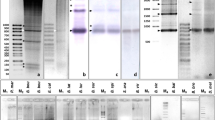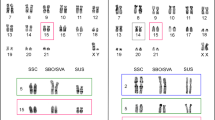Abstract
The genus of subterranean rodentsCtenomys presents the widest range of variability in diploid number among mammals (from2n=10 to2n=70). In Uruguay, this variability is observed in karyotypes with2n=44, 50 or 58 and two geographically isolated populations with 70 chromosomes but different karyotypic structure. The last three populations were analyzed in the present study. They present a satellite DNA, which was isolated from genomic DNA afterAlul digestion.In situ hybridization showed that this satellite DNA is located in the centromeric region of a few chromosomes, coincident with Hoechst 33258 staining and C-banding patterns. A similar satellite DNA was detected in Argentinian species of this genus. We established that, in spite of differences in number of positive heterochromatic blocks per karyotype, the C value is the same in the three populations studied. The nature and possible evolutionary path of this repeated DNA is discussed.
Similar content being viewed by others
References
Altuna CA, Lessa EP (1985) Penial morphology in Uruguayan species ofCtenomys (Rodentia Octodontidae).J Mammal,66: 483–488.
Bennett MD (1982) Nucleotypic basis of the spatial ordering of chromosomes in eukaryotes and the implications of the order for genome evolution and phenotypic variation. In: Dover GA, Flavell RB, eds,Genome Evolution. New York: Academic Press pp 239–262.
Cook JA (1990) Rapid chromosomal evolution and the systematics of the Bolivian tuco-tucos (Rodentia Ctenomidae). PhD, University of New Mexico, Albuquerque.
Gallardo M (1979) Las especies Chileans deCtenomys (Rodentia Octodontidae). I. Estabilidad cariotípica.Arch Biol Med Exp 12: 71–82.
Gallardo M (1991) Karyotypic evolution inCtenomys (Rodentia Octodontidae).J Mammal 72: 11–21.
Lee MR, Elder FF (1988) Yeast stimulation of bone marrow mitoses for cytogenetic investigation.Cytogenet Cell Genet 26: 36–40.
Maniatis T, Fritsch EF, Sambrook J (1982)Molecular Cloning: a Laboratory Manual. Cold Spring Harbor NY: Cold Spring Harbor Laboratory Press.
Nevo E (1979) Adaptive convergence and divergence of subterranean mammals.Annu Rev Ecol Syst 10: 269–308.
Novello A, Lessa EP (1986) G-band homology in two karyomorphs of theCtenomys pearsoni complex (Rodentia Octodontidae) of neotropical fossorial rodents.Z Saugetierk 51: 378–380.
Novello A, Sambarino C (1987) Dos Nuevos Cariotiposdel Género Ctenomys(Rodentia Octodontidae) del Uruguay. Córdoba, Argentina: Res. III Jornadas Argentinas de Mastozoología.
Novello A, Brum-Zorrilla N, Musto H, Bruzzoni H, Stoll M (1988) Cromosomas y caracterization del ADN deCtenomys pearsoni (Rodentia Octodontidae). Montevideo, Uruguay: V Reunion Iberoamericana de Conservacion y Zoologia de Vertebrados.
Novello A, Lessa EP, Sambarino C, Monzón S (1990) Chromosomal variation in two populations of the genusCtenomys (Rodentia Octodontidae) from Uruguay.Z Saugetierk 55: 43–48.
Pearse AGE (1968)Histochemistry, 2nd edn. London: Churchill Livingstone, pp 427.
Reig OA, Kiblisky P (1969) Chromosome multiformity in the genusCtenomys (Rodentia Octodontidae). A progress report.Chromosoma 28: 221–244.
Reig OA, Massarini AI, Ortells MO et al. (1992) New karyotypes and C-banding patterns of the subterranean rodents of the genusCtenomys (Caviomorpha Octodontidae) from Argentina.Mammalia 56: 603–623.
Rossi MS, Reig OA, Zorzópoulos J (1990) Evidence for rollingcircle replication in a major satellite DNA from the South American rodents of the genusCtenomys.Mol Biol Evol 7: 340–350.
Rossi MS, Pesce CG, Reig OA, Kornblihtt AR, Zorzópulos J (1993) Retroviral-like features in the monomer of the major satellite DNA from the South American rodents of the genusCtenomys.J DNA Seq Mapp 3: 379–381.
Rossi MS, Redi CA, Viale G, Massarini AL, Capanna E (1995) Chromosomal distribution of the major satellite DNA of South American rodents of the genusCtenomys.Cytogenet Cell Genet 69: 179–184.
Ruedas LA, Cook JA, Yates TL, Bickman JW (1992) Conservative genome size and rapid chromosomal evolution in the South American tuco-tuco (Rodentia: Octodontidae).Genome 36: 449–458.
Singh PB, Miller JR, Pearce J et al. (1991) A sequence motif found in Drosophila heterochromatin pattern is conserved in mammals and plants.Nucleic Acids Res 19: 789–794.
Sumner AT (1972) A simple technique for demonstrating centromeric heterochromatin.Exp Cell Res 75: 304–306.
Wreggett KA, Hill F, James PS et al. (1994) A mammalian homologue ofDrosophila heterochromatin protein I (HP1) is a component of constitutive heterochromatin.Cytogenet Cell Genet 66: 99–103.
Author information
Authors and Affiliations
Corresponding author
Additional information
Accepted for publication by M. Schmid
Rights and permissions
About this article
Cite this article
Novello, A., Cortinas, M.N., Suárez, M. et al. Cytogenetic and molecular analysis of the satellite DNA of the genusCtenomys (Rodentia Octodontidae) from Uruguay. Chromosome Res 4, 335–339 (1996). https://doi.org/10.1007/BF02257268
Received:
Revised:
Accepted:
Issue Date:
DOI: https://doi.org/10.1007/BF02257268




